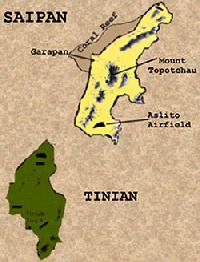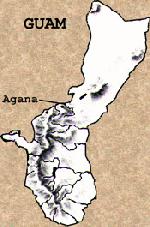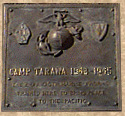
| CHAPTER FIFTEENuncommon valor was a common virtue." Admiral Chester W. Nimitz |
SAIPAN - GUAM
 ur survey section was sent in with the first waves to land on Saipan. As soon as the beach-head was assured, we scurried around with our transits, measuring chains and logarithm tables. We were responsible for finding desirable sites for the three gun batteries and the FDC.
ur survey section was sent in with the first waves to land on Saipan. As soon as the beach-head was assured, we scurried around with our transits, measuring chains and logarithm tables. We were responsible for finding desirable sites for the three gun batteries and the FDC.
The area may have been designated as "secure", but there were suicidal snipers in those graceful swaying palms. The Jap marksmen let the first troops move on and waited for special targets. No one wore any insignia of rank, but when a command post was set up it wasn't difficult to determine who was giving the orders. Officers and NCOs were the targets and they suffered a disproportionate number of casualites. I'm thankful that I was just a peon corporal at this time and didn't have enough clout to draw a sniper's attention.
As soon as the gun positions were surveyed, half the section set off to survey the target areas. The balance of the section was delegated to scouting out a good spot for our "survey center". This was always close to the battalion FDC because we had to deliver our plotted overlay to them as soon as possible. Since we were among the first to land we got to choose the best locations. Buildings were reduced to piles of rubble but we could always scrounge around and make a dry shelter. Compared to infantrymen, we lived in splendor.
 When the data was delivered it was plotted on overlays that tied the gun positions into the target area. FDC plotted this information on their firing charts and elevation and azimuth figures were transmitted to the gun positions. There was always a tense moment when the first spotting rounds were fired. If the survey section and the FDC personnel had done their jobs well, the first bursts would be close to the target. We never expected a perfect hit since we were firing on positions two to four miles away and using data scaled from a chart which measured about 20" x 24". At that scale, even the width of a pencil line could represent a hundred yards. I remember one time when our first shot was over a half mile from the target. Our battalion commander, Colonel Floom, turned to me and asked what the hell was wrong with us. We rechecked all our computations and could find no errors. I refused to believe that our field measurements and azimuth readings could be that far off. If we had to run a new survey, we'd be exposing ourselves to the Japs again, who were counter-attacking and things were really stirred up and chaotic out there in the target area. I requested that the gun section chief check his instrument readings and fire another round. This round was nearly right on the button. I remember that the target was a beached landing boat about two miles away. When it was blown apart, I couldn't resist turning to the colonel and asking, "Are we vindicated, Sir?". I got rewarded with a nod and a rare smile. Someone at the battery had read the gun sight wrong.
When the data was delivered it was plotted on overlays that tied the gun positions into the target area. FDC plotted this information on their firing charts and elevation and azimuth figures were transmitted to the gun positions. There was always a tense moment when the first spotting rounds were fired. If the survey section and the FDC personnel had done their jobs well, the first bursts would be close to the target. We never expected a perfect hit since we were firing on positions two to four miles away and using data scaled from a chart which measured about 20" x 24". At that scale, even the width of a pencil line could represent a hundred yards. I remember one time when our first shot was over a half mile from the target. Our battalion commander, Colonel Floom, turned to me and asked what the hell was wrong with us. We rechecked all our computations and could find no errors. I refused to believe that our field measurements and azimuth readings could be that far off. If we had to run a new survey, we'd be exposing ourselves to the Japs again, who were counter-attacking and things were really stirred up and chaotic out there in the target area. I requested that the gun section chief check his instrument readings and fire another round. This round was nearly right on the button. I remember that the target was a beached landing boat about two miles away. When it was blown apart, I couldn't resist turning to the colonel and asking, "Are we vindicated, Sir?". I got rewarded with a nod and a rare smile. Someone at the battery had read the gun sight wrong.
We landed with the 2nd Division near the town of Garapan and advanced eastward up the slopes of Mount Tapotchau, a 1,500 foot peak that dominated the island. The 4th Division landed on beaches south of us and bought their way southeast toward the Aslito airfield. The airport was taken on the fourth day and the 4th then pushed all the way across the island to the east shore. The Army's 27th Division then landed and conducted a mop-up operation on the Jap troops trapped on the southern tip.

Now an operation was launched to link the three divisions together in a line across the middle of the island for a sweep up to the northern end. The 2nd was on the left, 4th on the right, and the 27th in the middle. This plan looked good on paper but it didn't work out too well on the ground.
The Marine Corp's battle philosophy and the Army's tactics were miles apart. It's not a question of which is best. Both get the job done, but they won't work together side-by-side. The Marine strategy is to move forward as rapidly as possible, leap-frogging over pockets of resistance, leaving behind isolated snipers and machine gun nests for the rear echelons to clean out. The Army moves more slowly and deliberately, clearing out all resistance as they advance. The Marines have higher losses per day for fewer days. An Army campaign lasts longer but their daily casualty figures look better. I think it equals out in the end.
The push began at dawn. (Is this just tradition? Why do battles always "start at dawn"?) Things got off to a poor start and went downhill from there. Communications between the three divisions ranged from poor to nonexistent. The Marines did their thing; the soldiers did theirs. By midday there were gaping holes on both flanks ahead of the Army positions and it didn't take the Japs long to exploit these breaches. They slipped through and began attacking our troops from the rear. Finally, the Army moved up and the Marines fell back until the line was intact again. The Army Commander, General Ralph Smith, was replaced and the next day another assault began. This time things went smoother. The Marines and soldiers both tried to modify their battle techniques. We operated together very well during the balance of the campaign.
The 3rd Marine Division and the Army's 77th Division were still aboard the transports. They had been slated to assault Guam three days after our landing on Saipan but the approach of a Japanese task force and the SNAFU of our slowed march to the end of Saipan caused this invasion to be postponed. Salty Corporal Paull, veteran of Tulagi, Guadalcanal, and Tarawa, could have given some good advice to the generals and admirals and their vast (and half-vast) staffs of strategic planners. They should have pulled the 3rd Marine Division off the transports and made Saipan an all-Marine campaign. The 27th and the 77th Army Divisions could then have the honor of reclaiming Guam from the enemy. It's too bad no one had the good sense to ask for my input.
*** *** ***
Saipan was a well developed Japanese possession with a large civilian population. The Japanese civilians retreated up the island behind the Japanese soldiers. They were absolutely terrified of us. They had been well indoctrinated with stories of how they would be tortured and raped by the American barbarians. The Chamorro natives hated their Japanese oppressors. They infiltrated into our areas and helped us locate Japanese fortifications. I was on forward observer duty toward the end of the campaign and I was awed with the extra range and the devastating impact of our new howitzers. The 155's made our old 75's seem like pop-guns. It gave me a sense of omnipotence to be able to call down this rain of destruction on enemy positions. It also gave me an uneasy guilt feeling to see those shells exploding... knowing that human beings were being maimed and killed by these blasts too.
The northern tip of Saipan is a cliff with a sheer drop into the sea. At high tide the sharp coral rocks are almost covered with swirling surf. The Japanese civilians and the surviving soldiers were all crowded into this area. Now one of the worst horrors of the war occurred. In spite of loud-speaker messages asking them to surrender, and assurances that they would be well-treated, they began killing themselves. Soldiers clutched hand grenades to their bellies and pulled the pins. Through our spotting scopes from our observation post I witnessed this sickening spectacle. One of the worst experiences of my life.
*** *** ***
Saipan was finally declared secure. The two Marine divisions were pulled off the island for the attack on Tinian, another island about three miles away. Instead of going with them, we got loaded on an LST and sailed off to join a task force headed for Guam. We landed in mid-July in support of the Army's 77th on beaches near the south end of the island.
Guam is very different from Saipan. It's hard to believe it was only 100 miles farther south. Except for some flat palm groves and rice paddies on the western shore, the island is dense jungle, sharp ridges, and deep gullies. It was a tough, bloody battle for the Army and Marine infantry, but it was the easiest campaign that I experienced.

We did our surveys, then manned an observation post on a slope which overlooked Agana Bay. The dense jungle all around us made it impossible to see anything to the north and east of our position except tree tops, so after Agana was captured, we didn't have to do much. I'll always feel that I got a free ride on Guam. Fighting and dying was going on all around us but I was secure in an "almost intact" little house on a hill far from the bloody battles. Our section had a roof over our heads, dry floors under our blankets, and an uncontaminated well which supplied us with enough water to take an occasional bath.
My scariest time on Guam came after the island was declared secure. While awaiting transfer to ships to take us to our next adventure, we were assigned guard duty on the perimeters of the Brigade's position. We knew that many Japs were hiding out on the island. They would slip out and toss a grenade into a group of sleeping troops and disappear back into the jungle. Some of these soldiers hid out for months. (I even read of one Japanese who lived in the interior of Guam for over twenty years, always expecting rescue by his victorious nation.) I spent several spooky four-hour watches on the edge of a cane field, jumping every time a rat rustled the leaves... expecting a bayonet thrust in my back.
I was relieved when we were moved to the Agana docks and were allowed to get aboard a ship again. I expected that this time I must have acquired enough combat time to be sent back home. We did get sent back to a "home" of sorts. We docked at Hilo, Hawaii, and moved back into our old Camp Tarawa.




Memoirs Title Page
Tipi's Retreat

Copyright 1996 by /\/\ / ( /-/ = // =





| Memoirs Title Page | Tipi's Retreat |

Copyright 1996 by /\/\ / ( /-/ = // =